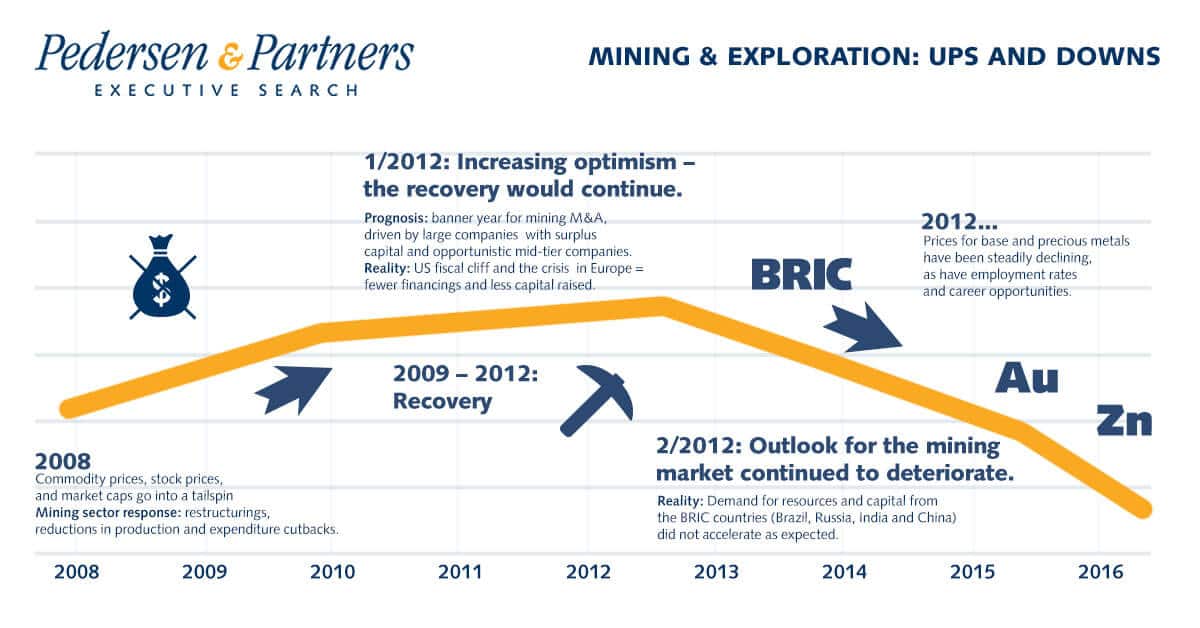Mining Industry: Talent Forecast
Toronto, Canada – The past six years have been turbulent for the global economy to say the least, and the mining sector is no exception. Based on the atmosphere at the recent PDAC Convention, although the outlook for 2016 is still very uneasy, there is some longer-term optimism for the sector. Numbers were down with 22,000 in attendance, but the overall outlook was more positive than last year, with precious metals and some other commodities starting to rally in price.

Looking back over the last few years, it is easy to see why there has been some apprehension concerning the market. The global recession that began in 2008 sent commodity prices, stock prices, and market caps in the mining sector into a tailspin. The sector responded with restructurings, reductions in production and expenditure cutbacks, and was improving by the second half of 2009. This recovery then continued steadily through to 2012.
The first half of 2012 was marked by increasing optimism that the recovery in the mining sector would continue. Some analysts predicted a banner year for mining M&A, driven by large companies with surplus capital and opportunistic mid-tier companies. Unfortunately, the fiscal cliff in the US and the economic crisis in Europe resulted in fewer financings and less capital raised, and the outlook for the market continued to deteriorate during the second half of 2012. To exacerbate matters, demand for resources and capital from the BRIC countries (Brazil, Russia, India and China) did not accelerate as expected. Since 2012 and until recently, prices for base and precious metals have been steadily declining, as have employment rates and career opportunities in mining and exploration companies.
However, when prices eventually recover in the sector, the demand for skilled employees will grow exponentially, and competition for talent will be fierce. The cyclical nature of the mining sector means that there is frequently a gap between supply and demand for talent, which in turn affects the availability of mining-related academic programs. A number of universities closed their mining programs in the late 1980s and early 1990s, and the impact of this is still being felt today, as the number of fresh graduates with relevant degrees is insufficient to meet even the basic needs of the industry during booms. Moreover, more than 40% of mining sector employees are over 50 years old, with one-third expected to retire by 2022. As the industry recovers, many mining companies will try to tempt back their retirees in order to mentor younger recruits.
Many companies now think that it is relatively easy to find skilled professionals, but the shortage of technical skilled labour is still one of the most pressing concerns in the sector. For example, metallurgists are always hard to source. Many of the university programs that have been cut involved metallurgy and metallurgical engineering, and students do not necessarily choose the subject as a specialisation when it is offered within mining engineering programs. With regard to project management, there are few qualified candidates with experience handling large-scale mining projects, so it is frequently necessary to complete a global search to fill this type of role. There will always be a shortage of skilled technical candidates unless we build more programs to educate them.
There is already a missing generation in the mining sector, with most employees over 50 or under 35. The rather small contingent of Generation Xers is largely due to the fact that the mining industry was going through a protracted downturn during the time when most of that group was graduating. The sector is at risk of creating the very same scenario with the youngest Millennials and the following generation failing to find positions in the mining sector.

In the last five to seven years, there has been a growth of interest in mining careers among Millennials, as they see the field as lucrative and highly technical. Unfortunately, while increasing numbers of students are entering and graduating from mining-related engineering and geological programs related to the mining industry, the industry is experiencing a growing dearth of opportunities for summer students and new graduates. The mining industry was rallying well when the current crop of students entered their programs, but as we have seen, the situation has changed drastically over the last four years. With a lack of opportunities in the sector, new graduates are increasingly seeking work in other sectors to make ends meet and entering graduate programs focused on entirely different industries.
Without a strong strategy for employee management, mining companies are facing significant challenges in terms of manpower, including the loss of senior and experienced personnel from the sector, and the prospect of a need to quickly mentor and train the younger talent during the next upturn.
The Mining Industry Human Resources Council report “Canadian Engineers for Tomorrow — Trends in Engineering Enrolment and Degrees Awarded 2009-2013” shows that across Canada, mining and minerals engineering programs are the fastest growing engineering disciplines. Enrolment has increased by 56% from fewer than 900 enrolments in 2009 to more than 1,300 in 2013. Essentially, this means that students graduating between 2011-2016 (and probably 2017) are or will be experiencing difficulty in procuring entry-level jobs and internships within the sector.
The mining sector must work hard in a joint effort with academic institutions to address this situation before it leads to another “lost generation” in the industry. According to industry experts, one of the simplest solutions is for larger companies to offer internship programs with numbers maintained throughout the peaks and nadirs of the mining economic cycle. These programs are not costly, and they can provide new graduates with a basic level of experience in the field. This however is an option that is open mostly to larger companies and it’s also clear that students frequently take matters into their own hands by enrolling in graduate programs to try to ride out the low end of a cycle. However, a protracted downturn may mean that they come out with advanced degrees, only to find that entry level positions (for which they may even be overqualified) are still non-existent. This can also backfire on the industry, when large numbers of students opt for MBAs or other programs leading to careers in entirely different industries.
How can the industry avoid another skills shortage when the sector enters into its inevitable recovery and upswing? A concerted effort to address this issue between academic institutions, government bodies, and industry leaders is imperative to iron out the issue of recurrent talent shortages in the mining sector.
*Generation X = born 1964-1980
This generation is sandwiched between the Boomers and the Millennials, and described as "underemployed, overeducated, intensely private and unpredictable." (source: Douglas Coupland, Generation X)
**Millennials = born 1981-2000
This generation consists primarily of the children of the Boomers, and is typically perceived as increasingly familiar with digital and electronic technology. (source: Oxford Dictionaries)
Pedersen & Partners is one of the fastest-growing, fully integrated Executive Search firms worldwide; it is 100% owned by its partners who all work full-time to serve its clients. The firm celebrated its 15th anniversary in January 2016, and to mark this occasion, it has created a timeline web page, featuring key milestones for the firm’s development and has released an anniversary video.
 Mary Murray is a Principal at Pedersen & Partners, based in Canada. Ms. Murray has almost 20 years of experience in providing strategic human resources, human services and customer service guidance to local and international clients in the mining, environmental, and natural resources sectors. Over the course of her career, Ms. Murray successfully implemented complex corporate talent acquisition initiatives, having completed numerous cross-border Executive Search assignments with two global Executive Search firms, and with one of the largest mining specialist recruitment consultancies in the world. Prior to rejoining Pedersen & Partners, Ms. Murray was the Vice President responsible for Executive Search for a leading American recruitment consulting practice with a focus on the mining and natural resources industries, advising on CEO, board and senior leadership solutions. She previously held several business roles for top industrial companies, such as: Hatch, ABB, and GE Water and Process Technologies, where she built and managed international talent acquisition projects.
Mary Murray is a Principal at Pedersen & Partners, based in Canada. Ms. Murray has almost 20 years of experience in providing strategic human resources, human services and customer service guidance to local and international clients in the mining, environmental, and natural resources sectors. Over the course of her career, Ms. Murray successfully implemented complex corporate talent acquisition initiatives, having completed numerous cross-border Executive Search assignments with two global Executive Search firms, and with one of the largest mining specialist recruitment consultancies in the world. Prior to rejoining Pedersen & Partners, Ms. Murray was the Vice President responsible for Executive Search for a leading American recruitment consulting practice with a focus on the mining and natural resources industries, advising on CEO, board and senior leadership solutions. She previously held several business roles for top industrial companies, such as: Hatch, ABB, and GE Water and Process Technologies, where she built and managed international talent acquisition projects.
Pedersen & Partners is a leading international Executive Search firm. We operate 56 wholly owned offices in 52 countries across Europe, the Middle East, Africa, Asia & the Americas. Our values Trust, Relationship and Professionalism apply to our interaction with clients as well as executives. More information about Pedersen & Partners is available at www.pedersenandpartners.com
If you would like to conduct an interview with a representative of Pedersen & Partners, or have other media-related requests, please contact: Diana Danu, Marketing and Communications Manager at: diana.danu@pedersenandpartners.com
